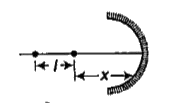A short linear object of length b lies along the axis of a concave mirror or focal length f at a distance u from the pole of the mirror. The size of the image is approximately equal to
lf(d+d)
d+ffl
lf2(d+f)2
l(d+f)2f2
The correct Answer is:C
The object is short and it lies on the axis of the mirror. Hence, differentiate for small variations of v and u.
For a mirror. 1v+1u=1f
⇒−dvv2−duu2=0
⇒duv2=−duu2
dvdu=−v2u2 (i)
Again 1v+1u=1f
⇒uv=uf−1=u−ff
⇒uv+1=uf
⇒vu=f(u−f)
⇒vu=−f(d+f) (ii)
From Eqs. (ii) and (i)
dvdu=−(fd+f)2 (Given du=f)
dvl=−(fd+f)2
⇒dv=lf2(d+f)2 [numerically]
Similar Questions
(a) A short linear object of length b lies along the axis of a concave mirror of focal length f at a distance u from the pole. What is the size of the image? (b) If the object begins to move with speed V0 , what will be the speed of its image?
View SolutionA short linear object of length / lies along normal to the axis of a concave mirror of focal length f at a distance d from the pole of the mirror. The size of the image is then (nearly)

View Solution
Knowledge Check
A short linear object of length b lies along the axis of a concave mirror of focal length f at a distanee u from the pole of the mirror. The size of the image is approximately equal to
Ab(u−ff)12Bb(fu−f)12Cb(u−ff)Db(fu−f)2A short linear object of length / lies along the axis of a concave mirror of focal length f at a distance d from the pole of the mirror. The approximate size of the image is
AIf(d+f)Bd+ffICIf2(d+f)2DI(d+f)2f2A short linear object of length b lies along the axis of a concave mirror or focal length f at a distance u from the pole of the mirror. The size of the image is approximately equal to
Alfd−fBd−flfClf2(d−f)2D(d−f)2f2l
A short linear object of length b lies on the axis of a concave mirror of focal length F at a distance u from the pole. The length of the image will be
View SolutionA very small object of length a is kept along the axis of a concave mirror of focal length y at a distance x from its pole. Approximate size of the image is
View SolutionA short linear object of length l lies on the axis of a spherical mirror of focal length f, at a distance x from the mirror. Then, the length of the image (P) so obtained will be

View SolutionA short linear object of length l lies on the asix of a spherical mirror of focal length f, at a distance x from the mirror. Then, the length of the image (P) so obtained will be

View SolutionWhat is the size of the image when a short linear object of length b lies along the axis of a concave mirror of focal length f at a distance u from the pole.
View Solution
